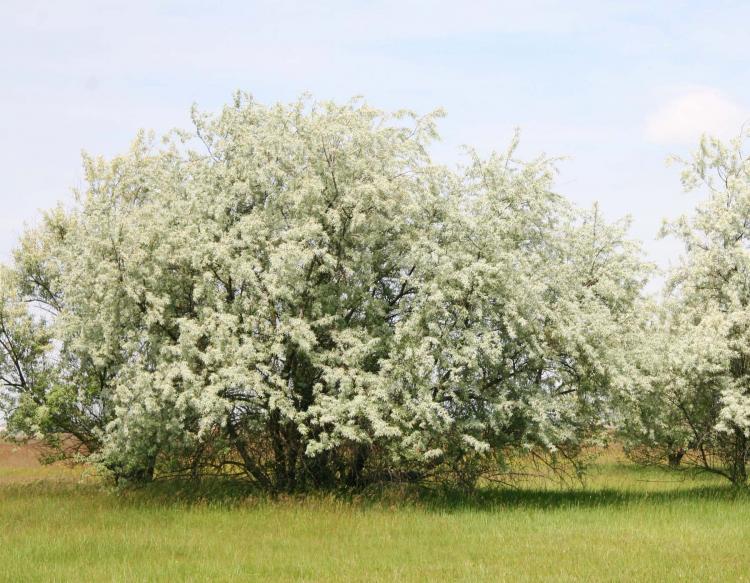*The following text, graphics, links, etc. were taken from “The Invader,” the Utah Weed Supervisors Association newsletter. Issue 1, Volume 2, Spring 2017, pgs. 5-6. For more details, please email utahweedsupervisors@gmail.com
Russian Olive is a major concern as an invasive species to Utah Lake. Many private land owners around Utah Lake have this invasive plant on their property. Russian olives are particularly difficult to kill. The saying goes, “when you tear a Russian Olive out of the ground, you invite 100 Russian Olives to the funeral, and they are really ticked off. (Patterson & Worwood, 2017.p.5)”
Russian olive (Elaeagnus angustifolia), once touted as a great habitat plant has become a habitat pariah, especially in southern Utah. Russian olive can choke out native plants, and wildlife diversity decreases in monoculture Russian olive stands.
Since 2005 we have been working to find an answer for the habitat takeover by Russian olive. Two absolute things we have learned from our research: 1) there is a straightforward method to kill Russian olive any time of the year; and 2) the work required to kill Russian olive is not easy. It requires more than just cutting or mechanically removing trees. Mechanical removal, which works well on evergreens such as pinion pine and juniper, does not work on Russian olives and many other deciduous trees. Either herbicide application or repeated cultivation is required. A common saying is that “when you tear a Russian olive out of the ground, you invite 100 Russian olive to the funeral, and they are really ticked off.” In addition, the resultant sprouts (crown sprouts and root suckers) are very hard to kill.
So, while we are continuing our research into Russian olive control techniques, we have not been able to get around the fact that we need to get “up close and personal” with the trees to be effective. The table below shows different treatment techniques, effectiveness, limitation and advantages of each, and where to find more information. Our research has shown that Russian olive is very susceptible to glyphosate herbicide. It translocates through the tree’s system better than other herbicides we have used. The most effective application technique is cut the stump herbicide application with glyphosate. Here are the guidelines:
- Cut tree to within 18” of the ground
- Cut all stems or trunks off at the same level to avoid nicking or undercutting a stem. Nicking the side of a stem stops herbicide from being translocated to the roots.
- Be sure the cut is quite level so herbicide won’t run off.
- Treat the outer growth rings (sad wood, just inside the bark) so herbicide can be translocated to the roots.
- Application rate is 1cc of undiluted herbicide (41% glyphosate) per inch of trunk diameter.
- Treat all the way around each and every stem.
This application method is effective any time of year. It is slow, difficult work, but once it is done the control is very good–nearly 100%. Some other methods may seem faster, but coming back to re-treat sucker growth takes more time in the long run. If you don’t have time to do it right the first time, when will you have time to do it again?
We are currently conducting more trials to see if there is a combination of herbicide application with mechanical removal that will give you satisfactory results.
Ron Patterson is the Utah State University Agriculture Agent in Morgan and Weber County Extension. He can be reached at 801-829-3472 or 801-399-8201.
Dennis Worwood is the Utah State University of Agriculture/ 4-H Agent in Emery County. He can be reached at 435-381-2381. Utah State University is an affirmative action/ equal opportunity institution.
| Chart 1: Management Techniques on Russian Olive
By: Ron Patterson and Dennis Worwood |
|||
| Technique | Effectiveness | Limitations | Advantages |
| Mechanical Removal |
Poor |
Requires years of retreatment or cultivation |
Easy from the seat of a tractor |
|
Foliar herbicide application
|
Fair |
Non-target plants can be damaged
Difficult to get herbicide into the leaf through the fuzzy surface Large plants not easy to treat |
Easy application for small plants |
|
Fire |
Poor |
Fire risk
Other plants damaged in fire may not recover |
None. Not effective on Russian olive |
|
Frill cut- herbicide application |
Fair |
Difficult to fight way to the trunk. Hard to treat multiple trunks. Not as effective on dormant trees |
Quite effective during growing seasons |
|
Basal Bark- herbicide application |
Good |
Poor control on steams larger than 6 inches in diameter. Only used with oil- based herbicides. May not prevent root suckering |
Stops basal sprouts by killing latent buds. Works well on smaller trees. |
| Cut stump-
herbicide application |
Excellent |
Difficult to fight way to the trunk
Slow work |
Nearly 100% effective year-round |
http://dnr.wi.gov/topic/Invasives/fact/images/RussianOliveA.jpg
For more information on the following Russian Olive treatment click on the links below.
Mechanical removal:
http://digitalcommons.usu.edu/extension_curall/1056/
Foliar herbicide application:
http://digitalcommons.usu.edu/extension_curall/1056/
Fire:
http://digitalcommons.usu.edu/extension_curall/1056/
Frill cut herbicide application:
http://digitalcommons.usu.edu/extension_curall/1074/
Basal bark herbicide application:
http://digitalcommons.usu.edu/extension_curall/1073/
Cut stump herbicide application:
Fact Sheet
http://digitalcommons.usu.edu/extension_curall/799/


Is there a recommended type of herbicide for the cut stump and poison strategy? Some 41% glyphosate herbicides say “grass and weeds” would those still work?
Is drilling the cut stump recommended?
Is covering the cut stump with a tarp or plastic required or recommended?
Eric,
Thanks for reading our blog post! Those are some great questions. We would recommend you contact Ben Stireman with Utah Division of Forestry, Fire and State Lands. That is who we got our info from. He should be able to answer all your questions! His email is bstireman@utah.gov or you can call their office at 801-538-5555. Best of luck to you!
How do you dispose of tree? Chipper? Fire? Other?
Natalia,
Thanks for the question. At Utah Lake, the removed trees are typically chipped, as we don’t want to remove an invasive plant to another location for disposal and hence further spread the plant.